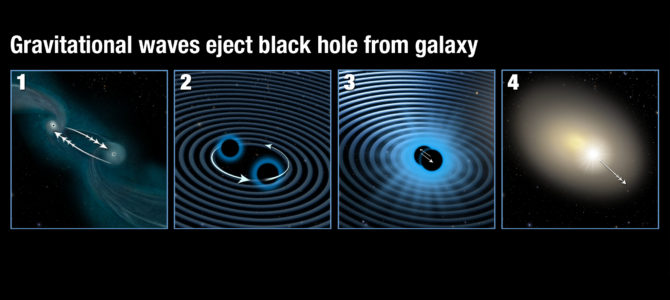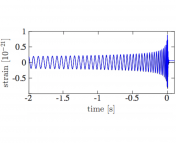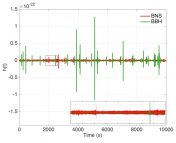Title: Black hole kicks as new gravitational wave observables
Authors: Davide Gerosa and Christopher J. Moore
Status: Physical Review Letters, open access
We have now entered a new era of astronomy: gravitational wave interferometers (constructed by the LIGO/VIRGO collaboration) have enabled us to observe astrophysical objects through the medium of gravitational waves. More than this – we recently detected gravitational and electromagnetic radiation from the same neutron star merger event in a historic example of multi-messenger astronomy. Gravitational wave detection is a tool we can employ to probe astrophysical phenomena that were previously invisible to us.
In today’s paper, the authors looked at a phenomenon called gravitational wave recoil. Gravitational wave emission can impart a momentum “kick” onto remnants of black hole binary mergers, and we can search for signatures of that kick directly in the form of the gravitational wave signals themselves. So, what is a black hole kick and what can we learn from them?
What is a black hole kick?
Thus far we have only observed gravitational waves produced by the coalescence of compact objects (such as black holes and neutron stars). As a pair of black holes orbit one another, they emit gravitational waves. Gravitational wave emission carries away energy and angular momentum, driving the binary into a progressively tighter orbit until the black holes finally merge in a violent collision. The characteristic gravitational waveform of this type of event is called a chirp and is depicted in Figure 1.

Figure 1. Top. Schematic of phases of a black hole binary coalescence. Bottom. Typical gravitational wave signal for a black hole binary coalescence. Source: http://ccrg.rit.edu/GW150914
Gravitational radiation can be preferentially emitted in a particular direction throughout this process. This means the gravitational waves carry away linear momentum as well as angular momentum from the binary. By conservation of momentum, the remnant of the black hole merger experiences a recoil imparted by the gravitational wave propagation. This recoil is also known as a black hole kick.
A toy model of gravitational wave recoil is presented in Figure 2 to demonstrate the concept. In an unequal mass binary, the smaller black hole moves faster than the larger one, causing the gravitational radiation to be beamed more effectively in a particular direction: there is a net ejection of momentum parallel to the smaller black hole’s motion. This is referred to as a beaming kick. Therefore, the centre-of-mass of the system recoils in the opposite direction, by conservation of momentum.

Figure 2. Instantaneous snapshot of gravitational wave recoil in an unequal mass binary, leading to a beaming kick. Schematic taken from https://arxiv.org/pdf/astro-ph/0408492v1.pdf.
How big are these kicks and do they matter?
A natural question to ask is: how big are these kicks, and do they have astrophysical consequences? This precise question has been analysed in great detail using both numerical and analytic techniques. The punchline of these analyses is that the problem must be tackled relativistically, because the recoil is most significant where spacetime is strongly curved. General relativistic effects, such as gravitational redshift, have a tendency to reduce the recoil the kick velocity, in comparison with Newtonian estimates. Gonzalez and coauthors predicted the maximum kick from non-spinning black hole mergers to be ∼ 170 km/s. They accomplished this using full numerical simulations, and their result is consistent with analytic estimates (for example, the estimate calculated by Sopuerta, Yunes and Laguna, which builds on an earlier estimate by Favata, Hughes and Holz depicted in Figure 3).

Figure 3. Left. Motion of centre-of-mass position of the binary. Right. Total centre-of-mass ejection velocity vs. distance between black holes. Solid blue lines correspond to quantities during the inspiral while dashed red lines are calculations during the plunge. Image from Favata, Hughes and Holz’s analysis in https://arxiv.org/pdf/astro-ph/0402056v2.pdf.
Nonetheless, the size of the recoil is still likely to be of astrophysical significance. Although non-spinning black holes are likely to only experience kick velocities of order 170 km/s, rapidly rotating black holes can produce far larger recoil velocities if the progenitor black holes are spinning in nearly opposite directions before the merger. These types of kicks are called spin kicks or superkicks and can be as large as 5000 km/s. The history of superkicks is outlined in this bite. The escape velocity for a globular cluster is typically ~30 km/s while a galaxy escape velocity is typically ~1000km/s, so we can see that kicks of this size could have substantial astrophysical repercussions. Black hole ejection from globular clusters appears very likely and even the ejection of supermassive black holes from their host galaxies is possible through the mechanism of superkicks.
Electromagnetic evidence for black hole kicks
The implications of black hole kicks for galaxy dynamics is striking: even if the superkick does not entirely eject the black hole from its host galaxy (as shown in Figure 4), it would at the very least displace the black hole from the centre of the galaxy, altering galaxy core dynamics for around 10 Myrs. Surely an event of this scale would be observable electromagnetically? Indeed, a number of candidate galaxies experiencing post-merger black hole recoil have been proposed (for example, see here and here) based on characteristic electromagnetic signatures they display. However, the precise nature of the electromagnetic observations is still up for debate and by no means conclusive; it is challenging to disprove alternative interpretations.

Figure 4: Schematic of a supermassive black hole being ejected from a galaxy due to gravitational wave emission. Image from http://www.deepstuff.org/gravitational-wave-kicks-monster-black-hole-galactic-core/
Direct observation of black hole kicks using gravitational waves
After observing the gravitational waves produced by a black hole merger, it is in principle possible to indirectly infer the size of the kick that the remnant received. However, this type of indirect approach relies heavily on the accuracy of our modelling techniques. As proposed in today’s paper, a far more powerful approach is to use the gravitational wave signal to directly observe black hole kicks.
The recoil of the centre-of-mass of the system leaves a clear imprint on the gravitational wave frequency. The gravitational wave signal is Doppler shifted by the kick velocity – if the centre-of-mass is kicked towards (away from) the Earth, the gravitational waveform will be blueshifted (redshifted). Crucially, the frequency shift is not homogeneous across the entire signal: rather it is largest during the last few orbits and merger phase. This is illustrated in Figure 5: as the kick accumulates in the later stages of the inspiral and merger, the Doppler shift becomes increasingly prominent.

Figure 5: Top and bottom. Gravitational wave signal with no kick (black solid), with a blue-shifted kick (blue dotted) and with a red-shifted kick (red dotted). Middle. Schematic of inspiral and remnant emitting red- or blue-shifted gravitational waves while experiencing a kick (black arrow). Gravitational wave curves taken from https://arxiv.org/pdf/1606.04226.pdf.
Is this effect detectable?
The authors of the paper did a back-of-the-envelope calculation to assess detectability and conclude that detecting these shifts with existing ground-based gravitational wave detectors is unlikely. However, measurements of supermassive black hole kicks larger than 100 km/s with space-based detectors, such as eLISA, looks very promising.
Observing supermassive black holes experiencing gravitational wave kicks is significant on two counts: (i) it confirms that supermassive black hole mergers take place in our Universe and (ii) tests the prediction that gravitational waves can impart linear momentum kicks. Just as the direct detection of GW150914 in 2015 confirmed that gravitational waves carry away energy as predicted by general relativity, a detection of the signature described in this paper would conclusively prove that gravitational waves carry linear momentum.




